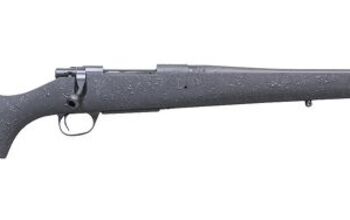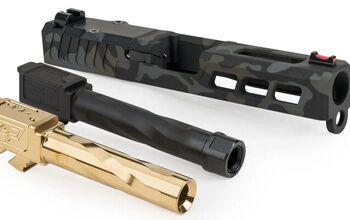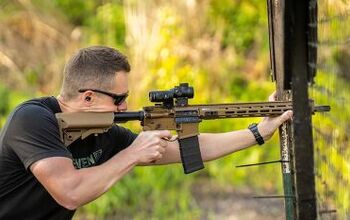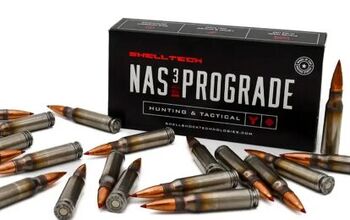TFB Review: Steyr Scout Mk II

The Steyr Scout Mk II is a unique rifle. It's not the first gun to wear the name “Steyr Scout,” but it keeps the features that made the original memorable while improving it in concrete ways. It's a one-of-a-kind blend of hunting rifle, precision rifle, and defensive carbine. Over the last several months I have used this rifle extensively, and it's time to share my findings.
Steyr @ TFB:
- POTD: Austrian Army – Sturmgewehr 77 A1 MOD (Steyr AUG)
- TFB Review: What Optic For A Steyr Scout? (Part 2)
- Master Your AUG – Talladega CMP to Host Steyr Academy Courses
- Steyr Arms Secures Contract for New Grenade Launcher with the German Bundeswehr
- The Steyr AUG 24″ HBAR Barrel Is Back!
Disclosures: Over the course of my Steyr Scout series I have developed a relationship with the company. I am an unabashed fan of Steyr rifles at this point and have a high opinion of the guys who work there. Steyr supplied this rifle for the review, I paid for ammo and range fees.
The First Look article covered many of the features of the Scout Mk II, so we won’t go over them again here. Be sure to read that article for the initial introduction to this rifle, as well as my articles on the original Steyr Scout if you want even more background on this family of guns.
TFB FIRST LOOK: The New Steyr Scout Mk II
TFB Review: Steyr Scout 6.5 Creedmoor (Part 1)
TFB Review: What Optic For A Steyr Scout? (Part 2)
TFB Review: The Steyr Scout 6.5 Creedmoor In The Field (Part 3)
With that, we will jump into the meat of the review without much preamble.
How Does It Shoot?
One of the selling points of a .308 over a 6.5 Creedmoor (or other more specialized caliber) is cheaper ammo. That's less true than it used to be, but historically speaking preppers like the .308 in a bolt gun or DMR because belted machine gun ammo could be used as an alternate ammo source if needed. The Scout is a jack of all trades, so I shot a variety of ammo ranging from M80 NATO ball ammo to match-grade boat tail hollow points. Across basically all ammo, accuracy is excellent. The best group of the test was with IMI Razorcore 175-grain boat tail hollow point ammo. The first three rounds were just over a quarter of an inch, and the fourth and fifth rounds brought the group up to 0.79 inches.
That kind of accuracy wasn't an outlier, though. It put five rounds of Red Army Standard steel case FMJ into 1.08 inches. It also averaged right at 1 MOA for 5-round groups with a cheap hand load I usually shoot in my PTR-91 (mixed headstamp brass, 168-grain Speer BTHP with thrown charges of 8208 XBR). It also shoots Armscor 168-grain just under 1 MOA for five-round groups.
A lot of the credit for this accuracy goes to the excellent trigger Steyr puts in this rifle. It's a light 2-stage trigger with an extremely consistent break. This one measures consistently at three points. I also employed the superb Leupold Mark 4HD 6-24x50 scope (review forthcoming, but it is a pretty exceptional optic) to take out as much human error as possible.
The Impact Of Heat
The Scout Mk II is a very lightweight rifle, weighing 6.6 pounds empty. One of the trade-offs with light rifles is the heat build-up. Guns generally shoot worse when they are hot than when they are not. Target rifles help mitigate that heat by using heavy barrel profiles, which can handle more rounds fired before the heat becomes an issue. That’s all well and good if the rifle is only carried from the truck to the firing line, but is not ideal on the side of a mountain.
In my review of the first-gen Scout, I fired 5-round groups for accuracy testing. Some of those groups were larger than I was expecting, and I discussed the accuracy results with my friend Jim from Steyr. He told me that their factory accuracy testing is done with 3- or 4-round groups.
With this rifle, I decided to do a little testing to see if the new design features made a difference or not. One test was checking to see how much the group expanded when the gun was very hot. I fired a ten-round group as fast as I could while maintaining accuracy. The ammo I was using was the bulk reloads mentioned earlier, which typically turned in around 1 MOA groups for 5 rounds, and a little less for 3 rounds. My first ten-round, rapid-fire group measured 1.19 inches. That is an excellent ten-round group for any rifle, and is phenomenal for a lightweight hunting rifle like this!
I was so shocked that I repeated the experiment. The next ten-round group measured 1.59 inches! The rifle had not cooled fully from the previous group, so that may have had some effect. There was also substantial mirage coming from the silencer which did not help with aiming.
Steyr’s changes to the Scout Mk II seem to make a major difference in how the rifle shoots when it is hot. The one-piece receiver and additional airflow around the barrel seem to make quite a difference.
Suppressor Use
The Scout Mk II is a light rifle, and a very light barrel contour is one of the ways that Steyr keeps that weight low. But the thin barrel does not have enough meat on it for the standard 5/8x24 thread pattern used on most .308 rifles. Instead, it is threaded 1/2x28. The original Scout was threaded 1/2x20, which generally required an adapter to another thread pitch to use common silencers. 1/2x28 may not be the most common for this application but it is still reasonably available.
The SilencerCo Scythe-Ti is an extremely light suppressor, weighing in at only 8.6 ounces with the anchor brake. That weight reduction comes from the tubeless design and full titanium construction. Steyr designed the Scout to be a quick-handling rifle that points easily and I did not want to mess up that weight and balance with a heavy suppressor. SilencerCo also sells a titanium direct thread adapter in 1/2x28, so there was no need for additional weight or potential tolerance stacking with a 1/2x28-to-5/8x24 thread adapter.
SilencerCo Scythe-Ti
And while the Scout Mk II is not a gun that kicks hard, less recoil is never a bad thing. Suppressors all tend to reduce recoil like a muzzle brake but without the added obnoxiousness. SilencerCo’s Anchor Brake takes that a step further by adding a brake on the end of the silencer, which further cuts down on kick without appreciably changing the sound of the gun. If I had to design a silencer for the Scout Mk II from the ground up, it would be a Harvester Evo and you can pick one up at Silencer Shop.
With the SilencerCo Scythe-Ti attached the groups shifted 1 MIL low and 0.5 MIL right from the unsuppressed zero. This was more of an academic observation though because I kept the silencer attached for essentially the entire review. It is just that much more fun to shoot with a can.
Accessorization
I decided to throw some accessories at the Scout Mk II to see if anything made sense. First up was a small cleaning kit to fit inside the storage compartment. I grabbed a Boresnake and a little packet of ALG Go Juice (pilfered from their SHOT Show booth) and, with a little convincing, secured both inside the compartment. There are better cleaning kits than this but it is enough to get by in a pinch.
Another opportunity was on the new MLOK sections under the handguard. I grabbed an Amazon-grade Arca plate and installed it. It is, unfortunately, just a little too wide to allow the built-in handguard to open. But for someone who would shoot from a tripod but never use the integrated bipod it is an option.
Lastly, I bought a couple of two-round holders backed with hook-and-loop from Amazon. I really like using shell cards on shotguns and wanted to try something similar on this gun. I put a section of loop by the bolt, and two on the stock. The ones on the stock did not provide much and I promptly removed them, but I kind of liked the “match saver” with two rounds set right by the action. Sliding one more round into the action was easy and consistent. With the magazine cutoff feature this could also be a way to have different bullets on hand and quickly accessible (e.g. solids for heavy game in the magazine, and a higher-BC bullet for longer shots).
Tactical Bolt Action?
Part of the allure of the scout rifle concept is that it can do most jobs well enough while still being easy to carry all day long. One way to think about the Scout rifle is as the DMR of bolt actions. A DMR is precision-oriented but still capable of doing other AR jobs too. The Steyr Scout Mk II is similar, in that it is an accurate hunting rifle, but still can handle jobs traditionally associated with semiautos. Its bread and butter work is hunting and controlling predators or varmints on a ranch, but it would still be reasonably capable in a defensive situation as well. The bolt throw is very fast, it points like an extension of the body, and it has detachable magazines, albeit with limited capacity. But if I had to choose a modern hunting rifle to take into an uncertain situation, I would take the Scout Mk II over any other option. I would still take an AR if that was my only consideration, but that’s not enough rifle for larger North American game animals, and depending on the configuration may not be appropriate for distance use.
One morning at the range I decided to mount a red dot and run some drills. 1-R-1 and Mozambique drills are not typical fare of hunting rifles, but with the Scout, they are on the menu. The bolt runs well with rapid cycling and all rounds fed and ejected without drama. Times were slower than would be expected with a semi auto, but still faster than seemed probable with a bolt action.
I also took the Scout Mk II out on a range day with one of my friends who is an avid shooter, but not a scout rifle guy. He also shot in the prior test of Scout rifle optics. The Scout Mk II was wearing a Trijicon Credo 1-10x28 FFP when he shot it, and that was a very effective combo. Transitioning between small steel plates set up around a valley was fast, and every time he pulled the trigger there was a hit. As a comparison, I had him shoot a PTR-91 at the same group of targets while standing. Even though there was no bolt to run between shots, he hit less consistently and slower with the PTR than the Scout. The light weight and fast handling of the Scout Mk II is tough to quantify, but shooting in the field in positions other than rested on a bench it is obvious.
Why Is The Steyr Scout Special?
The Steyr Scout Mk II executes the core tasks of a rifle, like accuracy and reliability, excellently. But there are a lot of other bolt action rifles out there that are accurate and reliable, and cost substantially less. What really differentiates the Scout from the rest of the pack is all of the additional features hidden on the gun. I forget there are flip-up irons on the gun because they are so tucked away, but they are available if they are ever needed. The spare magazine in the stock, and the ability to cut off the magazine feed for single loading are very handy, but are not noticeable. The stock also conceals a special storage space in the pistol grip which, as discussed, can hold a minimal cleaning kit. When the Scout is set to the “super safety” position, the bolt handle locks down tight against the action to avoid snags. But when the gun goes off super safe, the bolt handle pops back out for easy manipulation. And, of course, who can forget the handguard bipod?
All of these little details add up to a rifle that shines when it is in the field. This is not a gun that should spend its life shooting groups off of a bench or pretending to be a sniper rifle. It is a tool for people who spend time outdoors, and every effort has been made to make it easy to live with without compromising the accuracy or reliability. At the end of the day, the Scout is not a cheap rifle. These guns retail at the $2,000 price point because they are made in Europe and held to high standards. That extra expense is well worth it to people who spend a lot of time afoot with a rifle in hand, though it may not seem necessary to the kind of hunter that is never more than half a mile from their vehicle.
Conclusion
The Scout Mk II reminds me of a working dog. It is trained and has good manners, but it comes alive when it gets to work. Much like those dogs, you can feel that this gun’s spirit craves action. It wants to be in your hand on a backcountry trail or bouncing around in a muddy truck on some forgotten logging road. This is not a gun bred for sitting around the house or winning pageants. It is a gun that wants and deserves a few bumps and scratches earned in pursuit of wild game or defending livestock from predators. If you buy a Scout Mk II, you owe it to this gun to put it to work. Don’t buy this rifle if you never leave the pavement. But if you do tend to find yourself miles from cell service on a regular basis, you really should consider taking along a Steyr Scout.
TFB is proud to partner with Silencer Shop as our preferred vendor for all of your NFA needs. Whether you are searching for a new suppressor, SBR, or trust, Silencer Shop is here to provide a seamless and fast service for your next NFA purchase. Head over to www.silencershop.com to begin your NFA journey.

AKA @fromtheguncounter on Instagram. Gun nerd, reloader, attorney, and mediocre hunter.
More by Daniel Y



























![[SHOT 2025] Steyr Monobloc: The Barrel And Receiver Are One Piece!](https://cdn-fastly.thefirearmblog.com/media/2025/01/24/14161/post.jpg?size=350x220)














Comments
Join the conversation
Need a lefty, Steyr! Also, recently set up a Savage Axis .308 for suppressor use. Cut down to 16.5 inches, it still wasn't thick enough for 5/8x24 threads. So went to 1/2x28, and had to buy another mount for my YHM R2. Great setup, though!
Also, they make a 10-round mag and a 10-roud mag adapter kit that's readily available from Midwest Gun Works et al, so you can overcome the limitations of the factory mags.